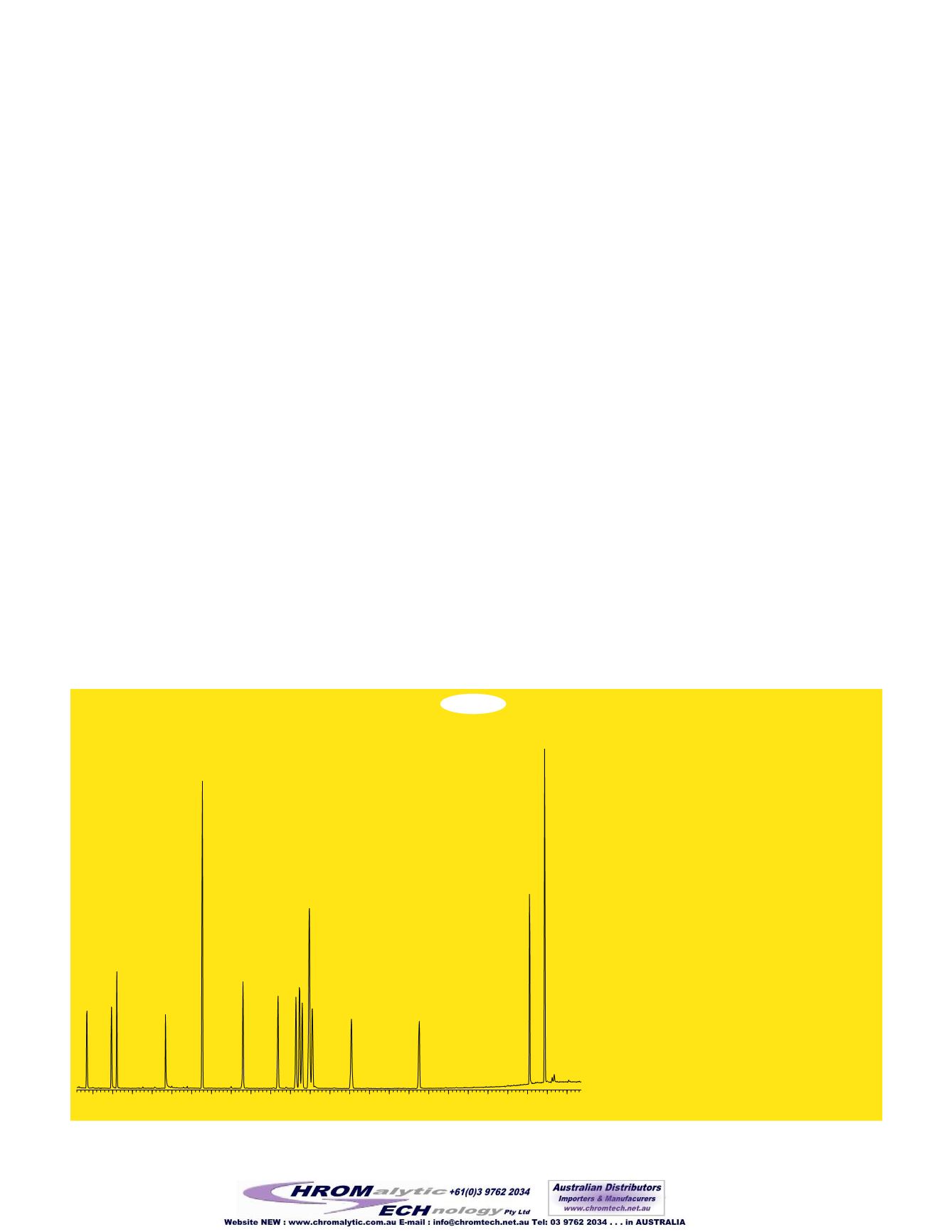

• 4 •
www.restekcorp.comThe US EPA recently developed GC/MS methodology
for screening finished drinking water for selected
semivolatile organic compounds not addressed by
the Safe Drinking Water Act (SDWA). These
Unregulated Contaminant Monitoring Rule (UCMR)
List 2 contaminants are part of a screening survey
established to determine whether in the future these
contaminants should be regulated by standard drink-
ing water methods. Method 526 is applicable for 11
of the 15 contaminants on List 2.* Compounds mon-
itored by Method 526 are effectively extracted from
water, using 47mm polystyrene divinylbenzene
(SDVB) solid phase sorbent, and are sufficiently
volatile and thermally stable for GC. The minimum
reporting level (MRL) concentration for UCMR List
2 is 0.5µg/L—the value of the lowest concentrations
at which precision and accuracy determinations
were made during method development.
After careful review of the method we have pre-
pared a new Restek calibration standard, as recom-
mended in Method 526, that includes all 11 semi-
volatile organic compounds at 200µg/mL each in
ethyl acetate. We also developed internal and surro-
gate standards, and we offer a GC/MS tuning solu-
tion at a convenient 2500µg/mL concentration in
methylene chloride (SV Tuning Compound, cat.#
31001; see page 7 of this newsletter). This set of
Restek reference materials will meet all chemical
standards needs for Method 526.
The majority of the target compounds analyzed
through EPA Method 526 are pesticides. Low-level
injections reduce sensitivity for many of these com-
pounds, due to degradation or irreversible adsorp-
tion in the injection port. Cyanazine, 2,4,6-
trichlorophenol, and prometon, for example, are
susceptible to adsorption or thermal degradation in
the GC inlet. To circumvent inlet problems, we use
a deactivated, Drilled Uniliner
®
liner in the inlet, to
significantly reduce sample exposure to the hot
metal surfaces of the injection port.**
In addition, when analyzing pesticides there are
demands on the capillary GC column for higher
inertness and lower GC/MS bleed: active sites in the
inlet liner or column can cause complete loss of
prometon and excessive tailing of 2,4-dichlorophe-
nol and 2,4,6-trichlorophenol peaks. Our silarylene
polymer-based Rtx
®
-5Sil MS column provides opti-
mal separation of the new reference materials and
exhibits very low column bleed, compared to tradi-
tional phenyl/methyl phases. The 30m, 0.25mm ID,
0.25µm column (cat.# 12723) used to obtain Figure
1 is an optimal combination of internal diameter
and film thickness, making it the choice for analyz-
ing many semivolatile compounds. It also is an
excellent choice for EPA Method 8270. The thin
phase film reduces analysis time, and high tempera-
ture stability (330/350ºC) enables an analyst to use
a rapid temperature program during the analysis,
and to bake high boiling contaminants out of the
column after each analysis, without significant
bleed.
We highly recommend these new reference materi-
als, a Drilled Uniliner
®
inlet liner, and an Rtx
®
-5Sil
MS column to anyone conducting analyses accord-
ing to Method 526.
See product listing on the next page.
by Katia May, Ph.D., R&D Chemist, and Christopher English, Environmental Innovations Chemist
GC/MS Screening of Semivolatile
Organic Compounds in Drinking Water
Using New Restek Reference Materials and a
Capillary Column with Optimized Dimensions
✔
Full complement of new reference materials for EPA Method 526: calibration standard,
internal standard, surrogate standard.
✔
Rtx
®
-5Sil MS column offers low GC/MS bleed and excellent inertness.
✔
Styrene/divinylbenzene extraction disks for sample preparation.
Figure 1
An inert, low-bleed Rtx
®
-5Sil MS column is an effective analytical tool for unregulated drinking water contaminants.
*For information about UCMR limits, see
http://www.epa.gov/safewater/methods/unregtbl.html**For more information about Drilled Uniliner
®
inlet liners, see page 13.
6
7
8
9
10
11
12
13
14
15
16
17
18
14
15
16
13
12
10
9
8 7
6
11
5
4
3
1
2
GC_EV00656
Rtx
®
-5Sil MS, 30m, 0.25mm ID, 0.25µm (cat# 12723)
US EPA Method 526 analytes, 1µL, 10ppm (20ppm IS)
Semivolatile Calibration Mix, EPA 526
cat.# 31691
Surrogate Standard Mix, EPA 526
cat.# 31693
Internal Standard Mix, EPA 526
cat.# 31692
Inj.:
1.0µL splitless (hold 0.3 min.), 4mm Drilled
Uniliner
®
(cat.# 21055)
GC:
Agilent 6890
Inj. temp.:
300°C
Carrier gas:
helium, constant flow
Flow rate:
0.8 mL/min.
Oven temp.:
50°C (hold 1 min.) to 200°C @ 20°C/min.
(hold 5 min.) to 310°C @ 30°C/min.
(hold 3 min.)
Det:
Agilent 5973 GC/MS
Transfer line temp.:
280°C
Scan range:
35-550 amu
Solvent delay:
5.5 min.
Tune:
DFTPP
Ionization:
EI
1. nitrobenzene
2. 2,4-dichlorophenol
3. 1,3-dimethyl-2-nitrobenzene (ss)
4. 2,4,6-trichlorophenol
5. acenaphthene-d10 (IS#1)
6. 1,2-diphenylhydrazine
†
7. prometon
8. terbufos
9. diazinon
10. fonofos
11. phenanthrene-d10 (IS#2)
12. disulfoton
13. acetochlor
14. cyanazine
15. triphenylphosphate (ss)
16. chrysene-d12
†
Mix component 1,2-diphenylhydrazine is oxidized to
azobenzene, the analyte in the figure, on injection onto
the heated column.


















